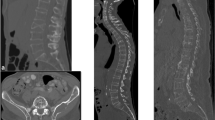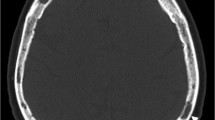Abstract
Aim
The aim of the study is to assess the feasibility of whole-body low-dose computed tomography (WBLDCT) in the diagnosis and staging of multiple myeloma and compare to skeletal survey (SS), using bone marrow biopsy and whole-body magnetic resonance imaging (WBMRI; where available) as gold standard.
Materials and methods
Patients referred over an 18-month period for investigation of suspected multiple myeloma or restaging of myeloma were randomized to undergo one of two WBLDCT protocols using high kVp, low mAs technique (140 kVp, 14 mAs; or 140 kVp, 25 mAs). Recent WBMRI scans were reviewed in 23 cases. Each imaging modality was assessed by two radiologists in consensus and scored from 0–3 (0 = normal, 1 = 1–4 lesions, 2 = 5–20 lesions, 3 ≥ 20 lesions/diffuse disease) in ten anatomical areas. Overall stage of disease, image quality score, and the degree of confidence of diagnosis were recorded. Diagnostic accuracy of skeletal survey and WBLDCT were determined using a gold standard of bone marrow biopsy and distribution of disease was compared to WBMRI.
Results
Thirty-nine patients were evaluated. WBLDCT identified more osteolytic lesions than skeletal survey with a greater degree of diagnostic confidence and led to restaging in 18 instances (16 upstaged, two downstaged). In those with recent WBMRI, distribution of disease on WBLDCT showed superior correlation with WBMRI when compared with SS. Overall reader impression of stage on WBLDCT showed significant correlation with WBMRI (κ = 0.454, p < 0.05). WBLDCT provided complementary information to WBMRI in nine patients with normal marrow signal following treatment response, but which were shown to have diffuse residual cortical abnormalities on CT.
Conclusion
WBLDCT at effective doses lower than previously reported, is superior to SS at detecting osteolytic lesions and at determining overall stage of multiple myeloma, and provides complementary information to WBMRI.









Similar content being viewed by others
References
Baur A, Stabler A, Nagel D, et al. Magnetic resonance imaging as a supplement for the clinical staging system of Durie and Salmon? Cancer 2002; 95: 1334–1345.
Durie BGM. The role of anatomic and functional staging in myeloma: description of Durie/Salmon plus staging system. Eur J Cancer 2006; 42: 1539–1543.
Mahnken AH, Wildberger JE, Gehbauer G, et al. Multidetector CT of the spine in multiple myeloma: comparison with MR imaging and radiography. AJR 2002; 178: 1429–1426.
Richardson PG, Sonneveld P, Schuster M, et al. Extended follow-up of a phase 3 trial in relapsed multiple myeloma: final time-to-event results of the APEX trial. Blood 2007; 110: 3557–3560.
Orchard K, Barrington S, Buscombe J, Hilson A, Prentice HG, Metha A. Fluoro-deoxyglucose positron emission tomography imaging for the detection of occult disease in multiple myeloma. Br J Haematol 2002; 117: 133–135.
Bredella MA, Steinbach L, Caputo G, Segall G, Hawkins R. Value of FDG PET in the assessment of patients with multiple myeloma. AJR 2005; 184: 1199–1204.
Durie BG, Waxman AD, D’Agnolo A, Williams CM. Whole-body 18F-FDG PET identifies high-risk myeloma. J Nucl Med 2002; 43: 1457–1463.
Antoch G, Vogt FM, Freudenberg LS, et al. Whole-body dual-modality PET/CT and whole-body MRI for tumour staging in oncology. JAMA 2003; 290: 3199–3206.
Brenner DJ, Hall EJ, Phil D. Computed tomography—an increasing source of radiation exposure. N Engl J Med 2007; 357: 2277–2284.
Cardis E, Vrijheid M, Blettner M, et al. The 15-country collaborative study of cancer risk in radiation workers in the nuclear industry: estimates of radiation-related cancer risks. Radiation Research 2007; 167: 396–416.
Horger M, Claussen CD, Bross-Bach U, et al. Whole-body low-dose multidetector row-CT in the diagnosis of multiple myeloma: an alternative to conventional radiography. Eur J Rad 2005; 54: 289–297.
Gleeson TG, Byrne B, Kenny P, Fitzpatrick P, O’Gorman P, Eustace SJ. Dose Optimization in Whole Body Low Dose Multidetector CT (MDCT) in the Staging of Multiple Myeloma. Scholars and Awards Session: Residents in Radiology Awards. ARRS Annual Meeting, Orlando, 8th May, 2007.
Buhmann S, Schoenberg S, Becker CR, Lang N, Reiser MF, Baur-Melnyk A. Whole-body imaging approach of patients with multiple myeloma: comparing MR imaging with MD-CT. Eur Radiol 2006; (Suppl 1): B–003.
Baur-Melnyk A, Buhmann S, Becker C, et al. Whole-body MRI versus whole-body MDCT for staging of multiple myeloma. AJR 2008; 190: 1097–1104.
Schmidt GP, Reiser MF, Baur-Melnyk AB. Whole-body imaging of the musculoskeletal system: the value of MR imaging. Skeletal Radiol 2007; 36: 1109–1119.
Walker R, Barlogie B, Haessler J, et al. Magnetic resonance imaging in multiple myeloma: diagnostic and clinical implications. J Clin Oncol 2007; 25: 1121–1128.
Durie BGM. Staging and kinetics of multiple myeloma. Sem Oncol 1986; 13: 300–309.
Kropil P, Fenk R, Fritz LB, et al. Comparison of whole-body 64-slice multidetector computed tomography and conventional radiography in staging of multiple myeloma. Eur Radiol 2008; 18: 51–58.
Huda W, Vance A. Patient radiation doses from adult and pediatric CT. AJR 2007; 188: 540–546.
Lecouvet FE, Malghem J, Michaux L, et al. Skeletal survey in advanced multiple myeloma: radiographic versus MR imaging survey. Br J Haematol 2000; 106: 35–39.
Weininger M, Lauterbach B, Knop S, et al. Whole-body MRI of multiple myeloma: Comparison of different MRI sequences in assessment of different growth patterns. Eur J Radiol 2007, December 18 (e-publication ahead of print).
Ghanem N, Lohrmann C, Engelhardt M, et al. Whole-body MRI in the detection of bone marrow infiltration in patients with plasma cell neoplasms in comparison to the radiological skeletal survey. Eur Radiol 2006; 16: 1005–1014.
Baur-Melnyk A, Buhmann S, Durr HR, Reiser M. Role of MRI for the diagnosis and prognosis of multiple myeloma. Eur J Rad 2005; 55: 56–63.
Horger M, Kna L, Denecke B, et al. The benefit of using whole-body, low-dose, nonenhanced, multidetector computed tomography for follow-up and therapy response monitoring in patients with multiple myeloma. Cancer 2007; 109: 1616–1626.
Chassang M, Grimaud A, Cucchi JM, et al. Can low-dose computed tomographic scan of the spine replace conventional radiography? An evaluation based on imaging myelomas, bone metastases, and fractures from osteoporosis. Clinical Imaging 2007; 31: 225–227.
Golding SJ, Shrimpton PC. Radiation dose in CT: are we meeting the challenge? (commentary). Br J Radiol 2002; 75: 1–4.
Lewis MA. Patient dose reduction in CT (Commentary). Br J Radiol 2005; 78: 880–883.
Mayo JR, Aldrich J, Muller NL. Radiation exposure at chest CT: a statement of the Fleischner Society. Radiology 2003; 228: 15–21.
Acknowledgement
No grants were received for this study; no conflict of interests to report.
Author information
Authors and Affiliations
Corresponding author
Rights and permissions
About this article
Cite this article
Gleeson, T.G., Moriarty, J., Shortt, C.P. et al. Accuracy of whole-body low-dose multidetector CT (WBLDCT) versus skeletal survey in the detection of myelomatous lesions, and correlation of disease distribution with whole-body MRI (WBMRI). Skeletal Radiol 38, 225–236 (2009). https://doi.org/10.1007/s00256-008-0607-4
Received:
Revised:
Accepted:
Published:
Issue Date:
DOI: https://doi.org/10.1007/s00256-008-0607-4




